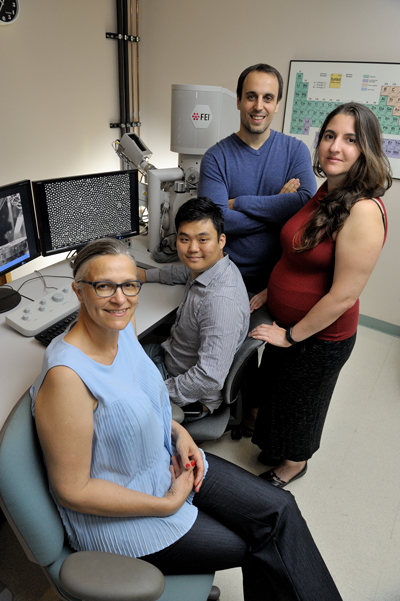“Insects did it first. Can engineers do it better?”
That’s the title of Marianne Alleyne’s blog, a site where this research scientist in entomology shares her work on bioinspiration. It’s a topic she describes as studying “how non-entomologists can be inspired by nature in general, and insects in particular, to create new technological innovations.”
 From left, Marianne Alleyne, a research scientist in entomology; Junho Oh, a student in mechanical science and engineering; Nenad Miljkovic, an assistant professor of mechanical science and engineering; and Catherine Dana, a student in entomology,
study how nature can inspire technological advancements.
From left, Marianne Alleyne, a research scientist in entomology; Junho Oh, a student in mechanical science and engineering; Nenad Miljkovic, an assistant professor of mechanical science and engineering; and Catherine Dana, a student in entomology,
study how nature can inspire technological advancements.
The Microscopy Suite at the Beckman Institute—part of the Imaging Technology Group—provides some of the tools that assist Alleyne with that bioinspired work, some of which involves examining cicadas.
Why study that particular summer sound-maker? Because the wings of cicadas have special properties that can inspire innovation in materials development.
“Cicadas have nanoscale structures on their wings that provide favorable reflectivity, which is very important to ensuring the cicadas won’t be observed by predators,” Alleyne said. “That structure also results in their wings being super-hydrophobic, or super-water-repellant, which also makes them self-cleaning because as water collects on the wings it actually picks up and removes any dirt. Then when the droplets fall, they take the dirt with them. In extreme cases, droplets actually bounce off the wing’s surface, possibly even removing heat. There’s also research that indicates that these structures could be antimicrobial.”
How does this information about cicada wings help us to fabricate materials that have the same beneficial properties? Alleyne’s collaboration with Nenad Miljkovic, an assistant professor of mechanical science and engineering, and Don Cropek, a chemist at the U.S. Army Corps of Engineers Construction Engineering Research Laboratory, is investigating that very question.
 The wings of cicadas have special properties that can inspire innovation in materials development.
The wings of cicadas have special properties that can inspire innovation in materials development.
Currently, chemicals are applied to materials in order to create these benefits, but the ultimate goal, explained Alleyne, “is to have super-water-repellant, heat-dissipating, self-cleaning, reflective, antimicrobial materials without adding chemicals.”
To put that bioinspiration into practice requires more research on the wings of different species of cicadas. That’s where the Microscopy Suite comes in.
The waxy cones on the wings are about 200 nanometers or billionths of a meter high. In comparison, the average human hair is roughly 100 microns or millionths of a meter wide.
“We need exceptionally high magnification to observe them,” Alleyne said. “The scanning electron microscope in the Microscopy Suite helps us to see the difference between the species in these structures. The information we receive from the imaging informs my collaborators’ work on materials. Once we fabricate materials, we go back to the electron microscope to be sure that the design looks and functions the same as what we saw in the cicadas.”
The structures visible in the Microscopy Suite don’t explain everything, Alleyne said. In addition to biology, chemistry also will need to be considered as her work with Miljkovic and Cropek moves forward.
“But we do know that the power of nature is in the small stuff. And the tools in the Microscopy Suite give us a chance to really see the small stuff,” she said.
Q&A ABOUT MICROSCOPY SUITE SERVICES
Marianne Alleyne, like many researchers across campus, uses the tools in the Microscopy Suite to further her work, provide opportunities for her students, and expand collaborations. Here, she shares her thoughts about the value the Microscopy Suite adds to her work.

In addition to your bioinspiration work with cicadas, what other ways do you use the Microscopy Suite?
I teach a course in insect physiology that is required for entomology graduate students, and they use electron microscopy to study the cuticle of insects.
Scott Robinson, manager of the Microscopy Suite, and Cate Wallace, a microscopist, are exceptional and patient in training the students to use the equipment as they image insects. The Bugscope project, initiated by the Microscopy Suite, also is important to our studentAs’ work because it helps them to learn outreach by communicating with students in K-12 and their teachers about the microscopic world of insects.
What about future research?
We anticipate using the Microscopy Suite for a project on click beetles. When these insects are on their backs, they can right themselves 50 percent of the time by using a click mechanism. Basically, they store energy through friction and muscle tightening and then let go and jump up. The friction is created by a peg and a lip, which can only be seen with an electron microscope. As we determine which species we want to work with for this project, we’ll use the Microscopy Suite to help us. The engineering application for this work would be to create a small robot that can right itself without using its legs.
How do engineers and biologists benefit from this kind of work?
There’s much to be gained when biologists and engineers collaborate, and not just at the faculty level. I teach a class where engineering students and biology students work together on bioinspired projects. The biology students love their science and benefit from this collaboration by learning how to communicate their science better, putting it in a language others can understand, and thinking of applications for the science. Engineering students tell me it’s great to look at nature as a way to come up with design solutions. It gives them another tool in their toolbox. They also look at it as an opportunity to design in a better way than nature because nature has certain constraints that engineers don’t.